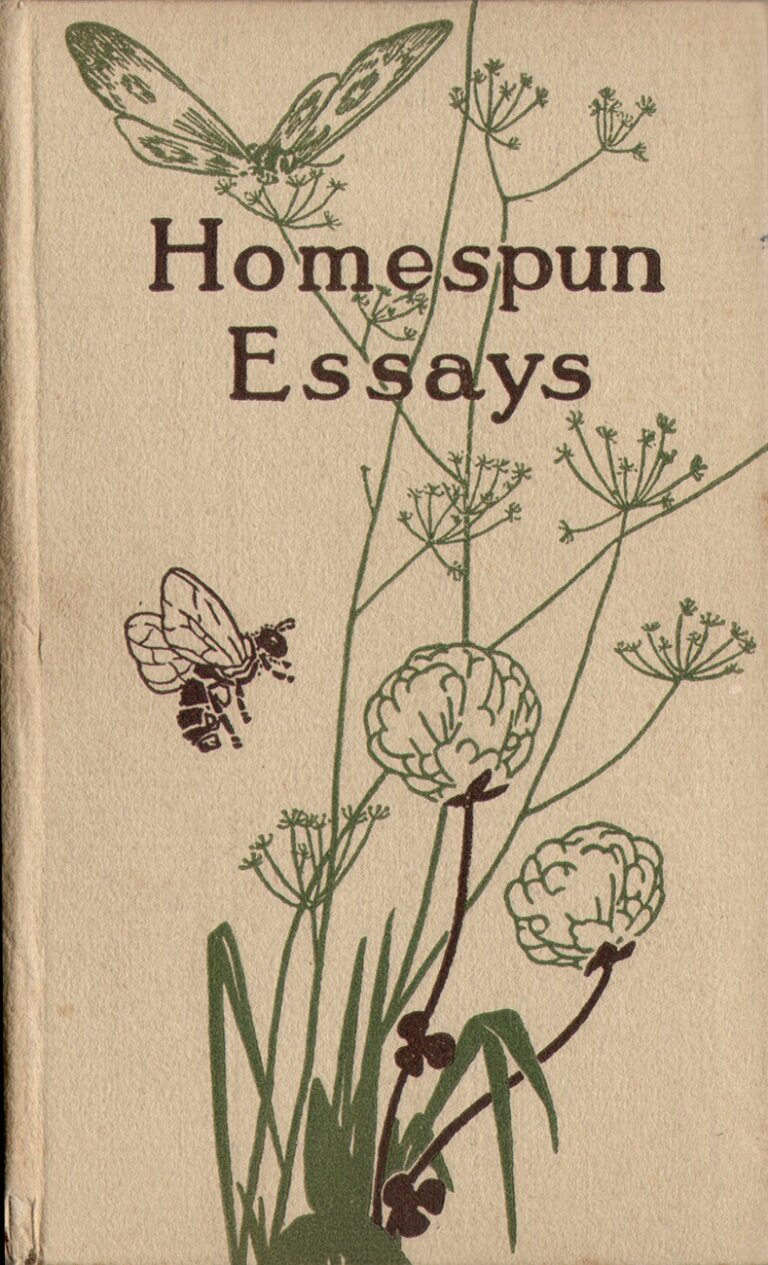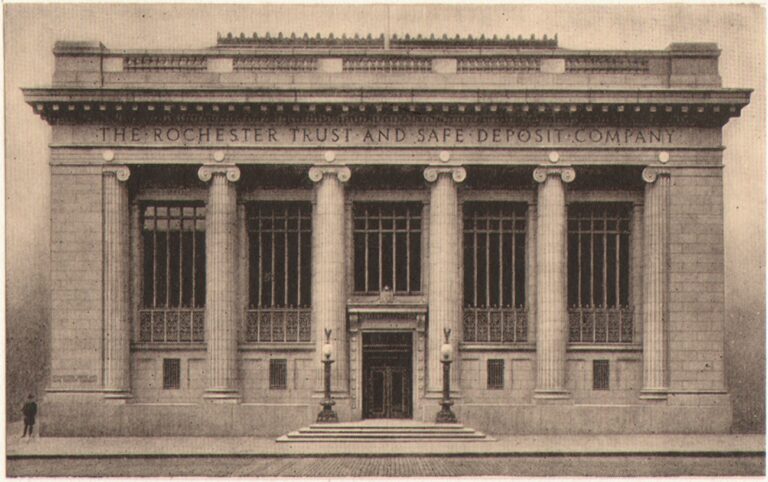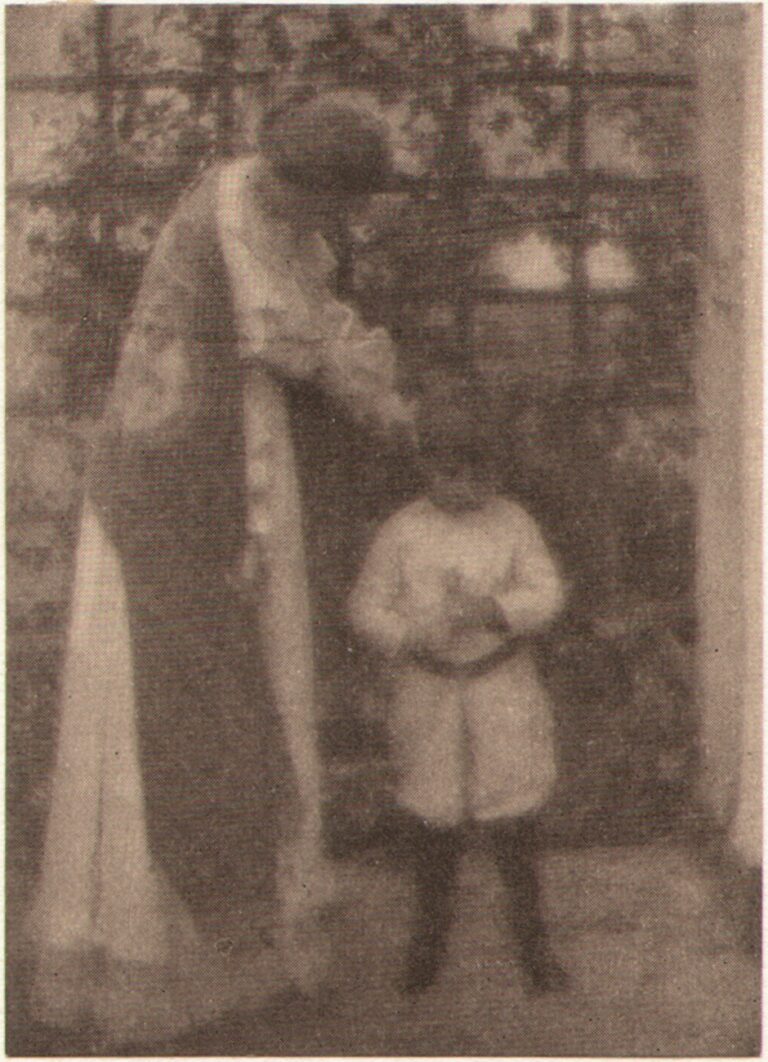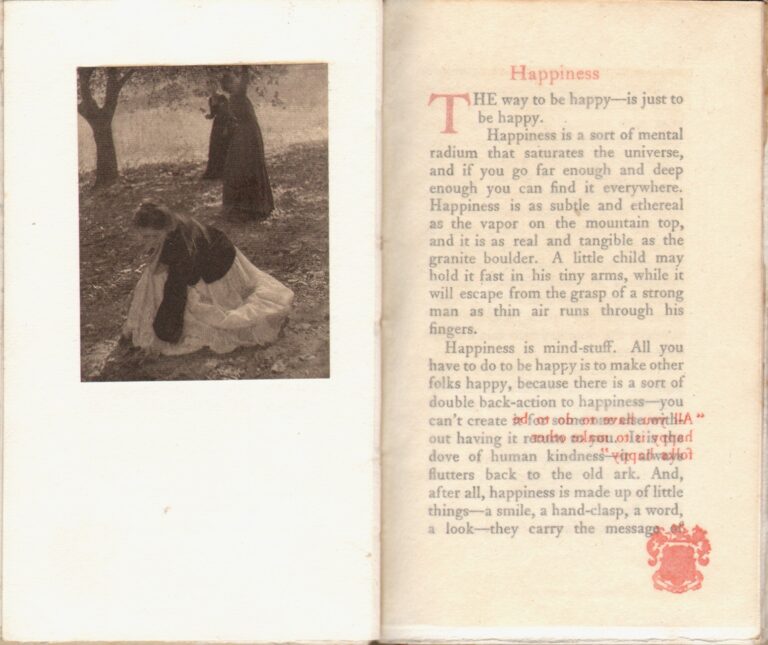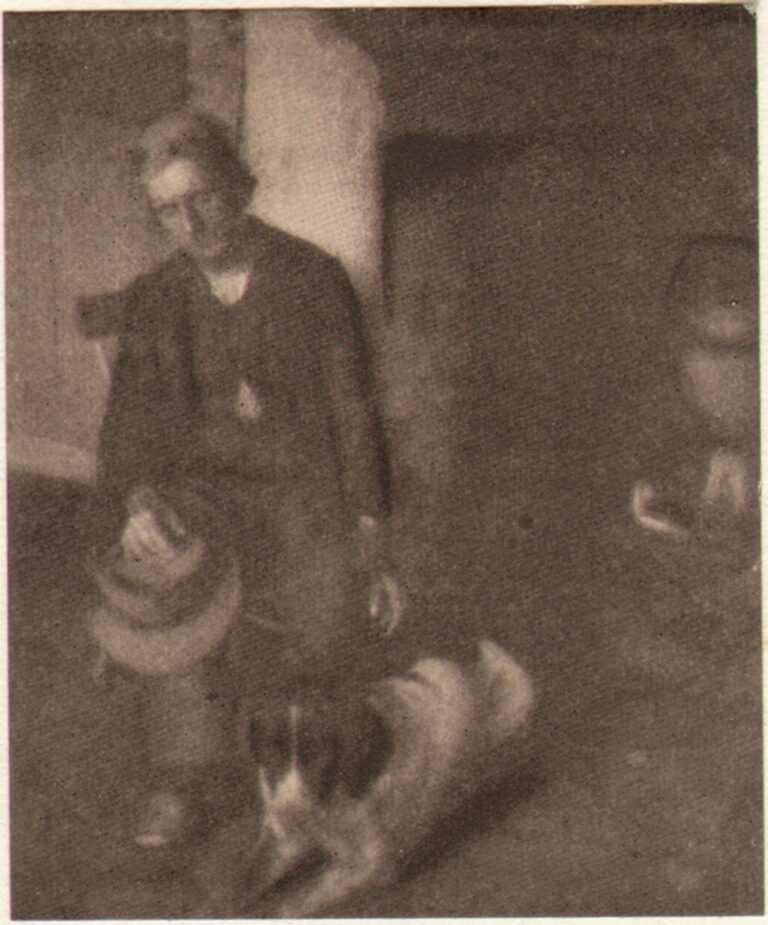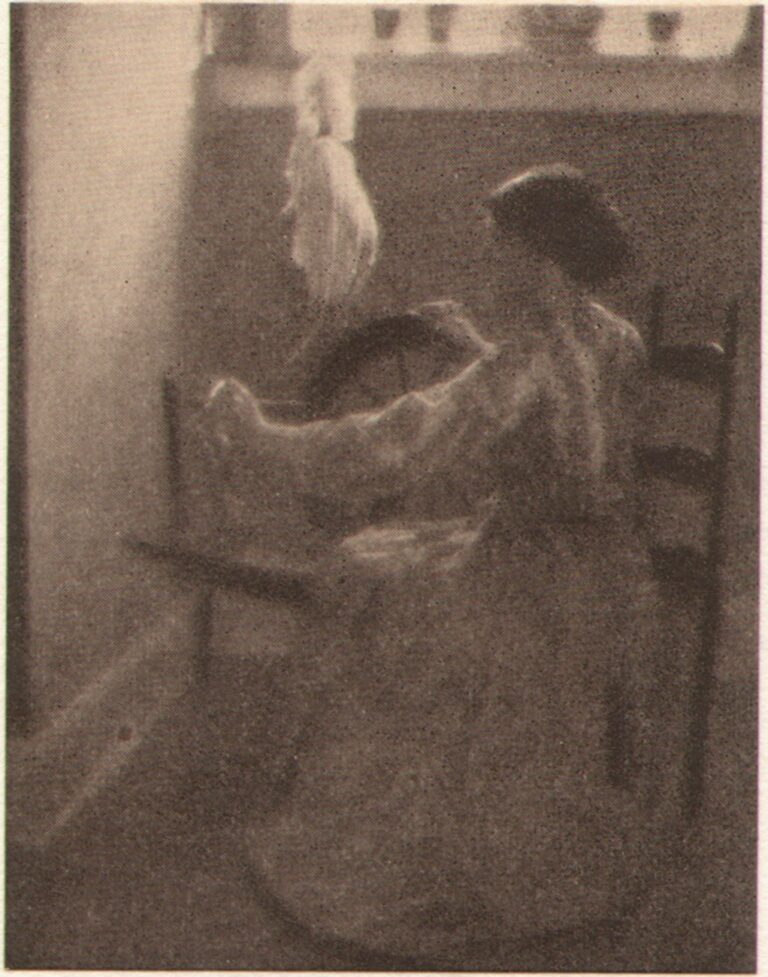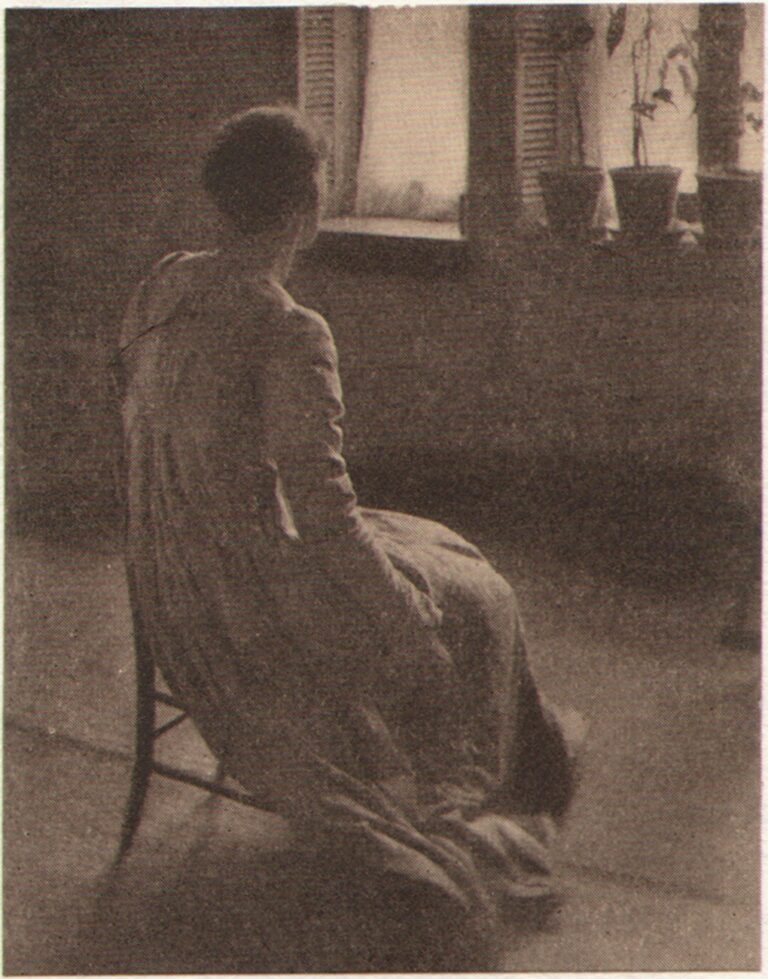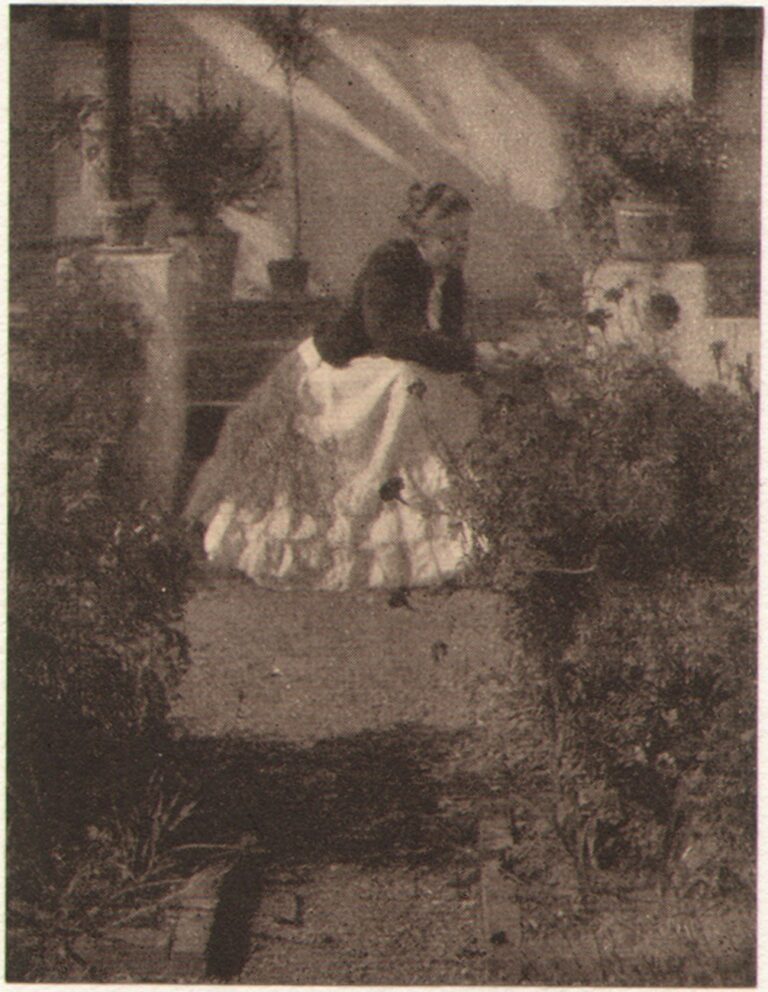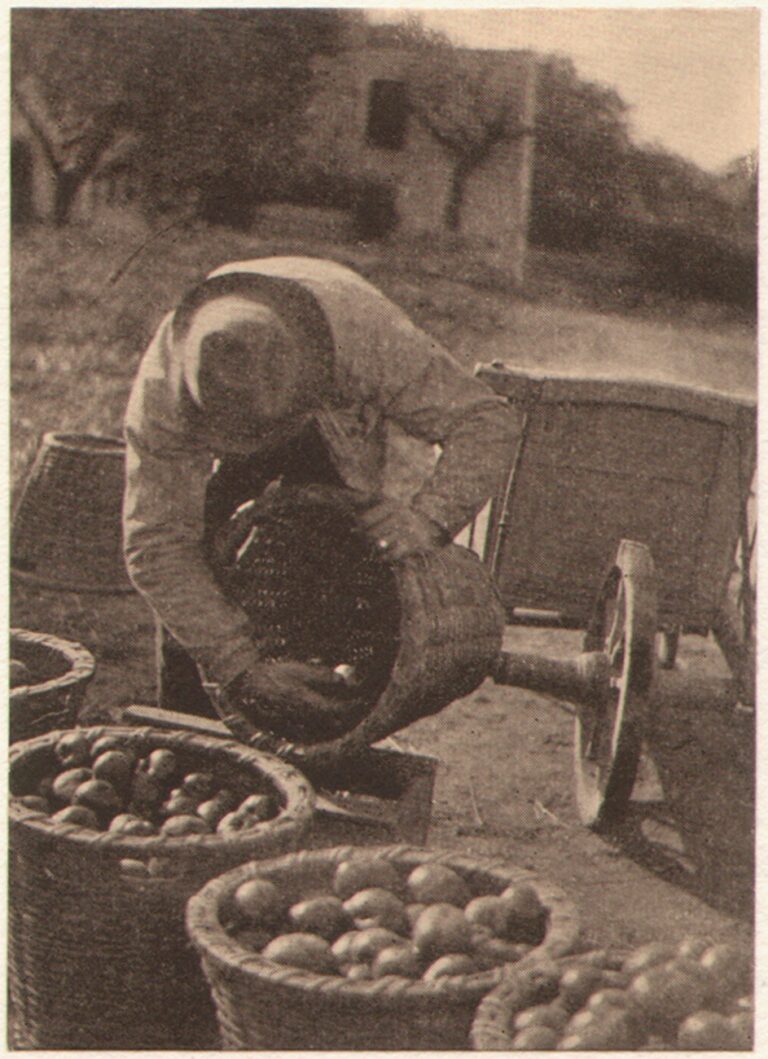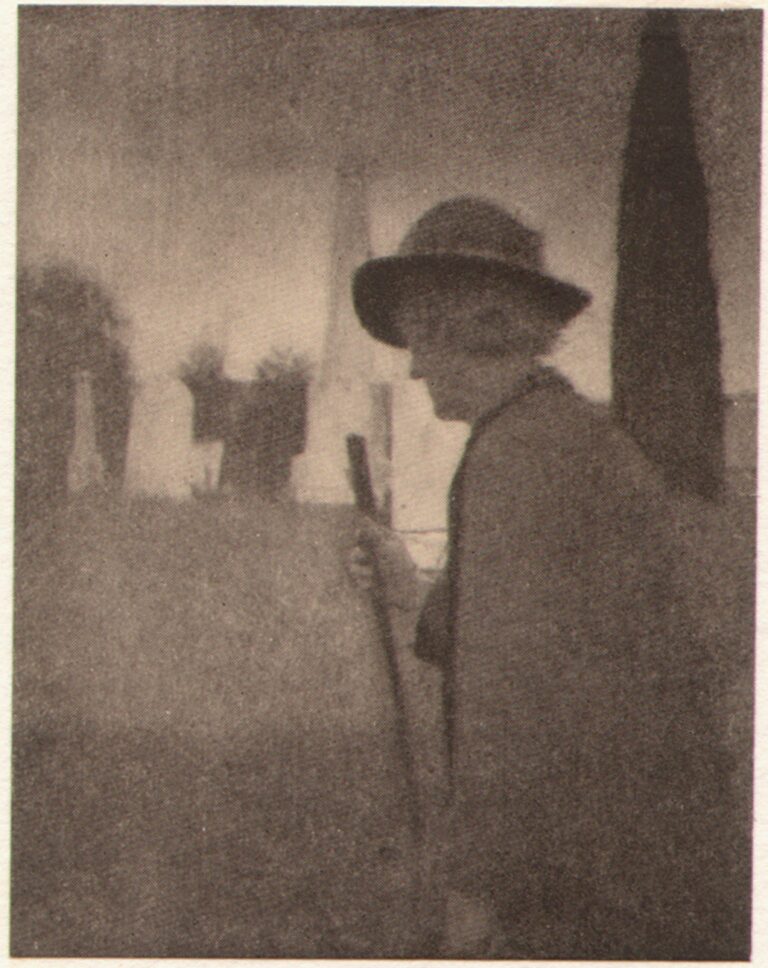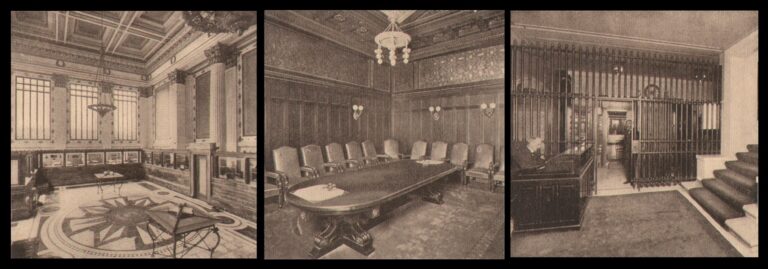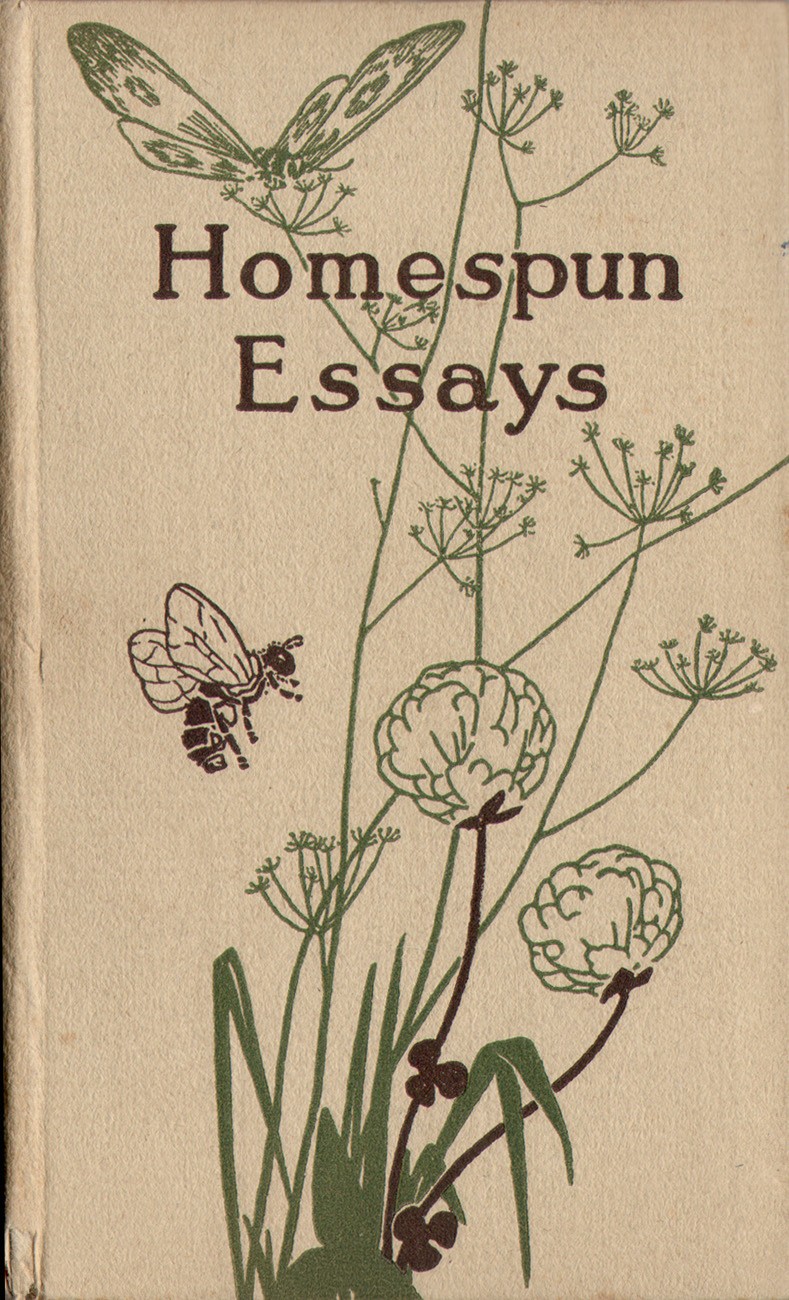
Homespun Essays
note on plate titles: unless it is a known work, we have used the corresponding essay title for the title of each photograph.
Introduction
In December of 1906, the Rochester Trust & Safe Deposit Company of Rochester, New York published a small promotional volume titled Homespun Essays – Everyday Thoughts About Everyday Life. Originally issued in an unadorned slipcase, it was printed on hand-made paper and illustrated with fine quality, tipped halftone photographs printed on Japanese Vellum. Curiously, these plates included seven photographs by the American Photo-Secession founder members Clarence Hudson White and Gertrude Käsebier. Seven are by White and one is by Käsebier. All of the plates are tissue-protected, supplemented with four additional fine commercial photographs showing off the banks amenities and featuring short, “Homespun Essays” after the White and Käsebier photographs extolling words to live (and save) by. These range from the topics of happiness and patience to the value of having friends in your life.
Preface & Volume Particulars
The short preface to the volume describes its’ purpose:
“This little book is affectionately dedicated to the friends who share with us an appreciation and love for the homespun things of life, or we might say the dayspun things; those simple thoughts and true which we daily weave into life’s fabric and that really make it worth while.”
In actuality, the volume was part of a shrewd marketing campaign put on by the bank, which in the same year of publication (1906) opened up their brand-new Greek Revival temple to savings in the downtown Rochester area known as the “Four Corners” (sw corner of Main and Exchange streets). (1.) Cleverly written into the volume’s essays were admonishments that saving accounts opened at this bank gave the owner a return of 4% interest:
from the essay “Happiness”:
“There is nothing that grows so surely as money, and there is no surer way to lay the foundation of happiness for to-day and to-morrow and of the years to come than the methodical saving from the daily income. And the best and safest way to save is to put your money in the Rochester Trust and Safe Deposit Company, where it will earn 4 per cent interest. Money does not burn a hole in the Trust Company’s pocket, as it does in the pockets of some folks.” 2.
Around the time the bank began planning an expansion of its’ Rochester operations, (1904) none other than the civic-minded head of the Eastman Kodak Company-George Eastman-was on its board of directors. (3.) It is not known what role Eastman played two years later in the solicitation of and marketing of savings accounts to the general public but given his aggressive efforts at this time with the Kodak brand, it’s not surprising the bank enlisted the efforts of advertising agent Otis H. Kean to arrange and print Homespun Essays in 1906. 4.
Otis H. Kean: Advertising Agent Extraordinaire
In trying to determine how artistic pictorial photographs ended up being used in the volume Homespun Essays, it’s instructive to learn a bit about Otis H. Kean, a book publisher who maintained an advertising agency known collectively as the Literary Print Shop at 140 Nassau street in New York City as early as 1902. 5.
A decade earlier, in 1891, the earliest employment record for Kean known at this time lists him as working for the Census Office of the U.S. Department of the Interior in Washington D. C. . (6.) A line item job description entry with the Official Register of the United States lists Kean as also having been born in New York State, so it’s a surprise to find him claiming to have been born in Washington D.C. in the later Federal U.S. Census of 1900. His wife Maude Kean was also listed as having been born in Washington D.C. in 1900 but a later Census for 1930 states she was born in Canada, so it would seem there might have been a benefit to Kean for declaring it this way after having worked earlier for the U.S. Government. Other details emerge about Kean from the 1900 Census. He resided in Rockville Centre (Nassau County) New York. Besides his wife, family members in his household included older sister Jessie R. Meher, his younger sister Della Kean, and a servant, Virginia Andrews, an African American originally born in North Carolina the same year as Kean, 1873. ( 7.)
Before first moving to the greater New York (City) area sometime before 1900, Kean had left Washington and made his way eventually to Buffalo, New York. It was here in 1895 that Kean published The Buffalo Postal Guide, a quarterly publication of unknown content “under authority of the Buffalo postmaster”. (8.) In 1897, source material describes his business in Buffalo as “Compilers and Publishers | Advertising Literature”, and he produced and published the slim advertising brochure Glove Lore for The Paris Glove Store of S.W. Laird & Co. located at 190 Main Street. The item featured large artistic engravings of fall and winter gloves. (9.) Perhaps because of geography, it is probable he met his future wife Maude Kean, who was originally from Canada, around this time. Another indicator of Kean’s business savvy was copyright registration around this time and later in his career. Records for 1899 show at least two works registered: an advertisement for silk Barathea, historically used in the manufacture of neckties, and a small book or brochure for the use of Borax in tanneries and currying shops. (10.) This last copyright for Borax (a boron compound, mineral, and salt of boric acid used in detergents and many other products including cosmetics) would prove lucrative for Kean in the years to come, when he became active in promoting its’ many virtues to the public.
After arriving in New York and setting up business at 140 Nassau Street, (10a.) Kean hustled and secured advertising commitments from prominent purveyors of luxury items in the city, including classic furniture and rugs; (W. & J. Sloane) silverware; (The Gorham Company) paintings and engravings; (Schaus Art Gallery) and porcelain; (Gilman Collamore & Co.). The result was his publication in the fall of 1902 of the book: The Art of Giving. Author William McKendree Bangs wrote the copy which was illustrated by very fine, tipped halftone photographic plates. Kean was obviously going after the well-heeled demographic with this early effort and credit is given early to the advertisers featured in it:
“In the preparation of the following pages
information has been sought at sources of
undoubted importance and authority, — from
those firms, namely, whose collections are of
unquestioned prominence. Detailed descrip-
tion has not been possible; but it has been
the aim to make the book of practical value
as suggestive of obtainable worthy objects.
The illustrations are from articles contained
in the same collections:”. 11.
Kean also knew positive press notices would in turn secure more work for his new concern. The trade journal The American Printer soon weighed in with this short declaration on The Art of Giving:
“The book, which was 4 1-4 by 7 1-4 inches, was a beautiful piece of printing throughout and must have been a powerful advertisement for Otis H. Kean, the New York advertising specialist who issued it.” 12.
Pretty Girls and a Talking Mule
A major account for Kean’s advertising firm that soon followed The Art of Giving in 1903 was for the Pacific Coast Borax Company’s marketing campaign promoting its popular “20-Mule Team Borax” brand, which debuted in 1904. Perhaps as a result of his earlier efforts discussed here at copyrighting his book on Borax usage in 1899: “Borax in the Tannery and Currying Shop”, Kean secured the company’s favor in advertising their product in newspapers and magazines. For newspapers, this was done by his creation of the “Boraxologist”, an artist’s caricature of a wise mule extolling the many benefits and uses for Borax to the consumer. For magazines, Kean commissioned an artist to create the “American Girl Pictures”, a series of “five charming drawings of the loveliest types of that fascinating personality—the modern American girl”, all high-quality framable engravings obtainable by magazine subscribers when sending in a box-top from a one-pound box of “20-Mule Team Brand Borax”. (13.) The trade journal Printers’ Ink gives the background for both campaigns:
“The advertising of “20-Mule-Team Borax” that began in newspapers and magazines the first of this year is the most extensive campaign the Pacific Coast Borax Company has ever undertaken.”…The present campaign covers every nook and corner of the United States.”…The advertising of “20-MuleTeam Borax” is written and placed by Otis H. Kean, a general advertising agent at 140 Nassau street, New York….Copy for magazines and newspapers is quite different in theme. In magazines the company offers an American girl picture for framing on receipt of a box top from its product with a two-cent stamp, so that the magazine advertising seeks to sell goods direct through the retailer. If the piles of letters handled by the Kean agency are a criterion, this magazine advertising is bringing splendid results. The newspaper ads, on the contrary, are designed to educate the public in the many uses of borax. It is quite likely that they reach large numbers of people in cities who may not know borax even as a softener of alkali water. Short talks on the product under the title of “Boraxology” are illustrated with the “boraxologist”—a mule. “The object in employing the mule was to make the company’s trademark widely known,” said Mr. Kean. Boraxology is simply a pleasant little creed. This is an age of creeds and optimistic aphorisms. Such things seem to please the people. The Boraxologist preaches the creed of being kind and using plenty of borax, using plenty of borax and being hopeful, being enterprising, alert—and using plenty of borax. Some criticism has been leveled at the mule. Perhaps he isn’t beautiful. But he’s a trademark, and the point is to make him known.” 14.
Homespun Essays: Artful Sales Pitch
With the majority of the photographs published in Homespun Essays late in 1906 being the work of Clarence White, it would figure Kean had somehow run into him at some point in his travels in order to secure the work, or perhaps White had made a personal visit for some reason to Rochester around this time in order to conduct business with the bank. (15.) If this were the case, it would have been the same year White left his home in Newark, Ohio in order to pursue his professional photographic career in New York. (16.) In our estimation, a White visit to Rochester seems remote. More likely, White’s work came to Kean’s attention by way of Kean’s own business dealings within his own specialized publishing business in New York City. If this were the case, Kean most likely met Alfred Stieglitz around this time or earlier. To rationalize this claim, White’s and Käsebier’s work was conveniently on public display during a group show Stieglitz had mounted in his newly-opened Little Galleries of the Photo Secession in February of 1906. (17.) Additionally, in April, Stieglitz reproduced a halftone plate of this installation in his journal Camera Work the same year. (18.) Although it cannot be confirmed the photographs shown in the gallery were also the ones used in Homespun Essays without primary source material backing, it would have given Kean familiarity with their photographic style if he had chance of visiting the Little Galleries around this time. Alternately, he may have contacted the two photographers directly in order to secure the work, but almost surely by way of a brokered arrangement through Stieglitz.
Kean continued to promote his business through trade journals at this time, and may have succeeded in catching the attention of the Rochester Trust & Safe Deposit Company that his services would be a good fit for promotional purposes. To this end, in January of 1906, Kean and the Quadri-Color Company, specialists in four-color printing located at 32 Union Square in New York City, were mentioned together in the Manufacturer’s Paper, a trade journal for American manufacturers:
“Two concerns, makers of advertising, that send in samples of their work, are the Otis H. Kean advertising agency and the Quadri-Color Company. Mr. Kean and his artists and writers chiefly devote themselves to turning out booklets, though they handle general periodical advertising for many concerns also. The way the Kean people are able to get the attention is by the use of a house organ magazine in miniature. They call their magazine “Gray Matter,” and announce that it is “published now and then for the edification of thinkers and advertisers,” not meaning by this, of course, to say too plainly that advertisers arc not thinkers as a general rule. Gray Matter is full of a cheerful philosophy in its reading pages somewhat after the manner of Elbert Hubbard, but it is not the reading pages that chiefly attract attention, but the get-up of the little book itself, the illustrations, the type and the cover, all of which are very much out of the ordinary.” (19.)
It would be inferred from this notice that the Quadri-Color Company had associated themselves with Kean’s agency, but it is not known if they were responsible for reproducing the superb multiple-color halftone photographic plates for Homespun Essays, as no atelier attribution for them appears in the volume. Surely they would have been up to the task however as they promoted themselves heavily in the trade during this time as cutting edge:
“…we desire to state that the Quadri-Color Company was the first to make a scientific and artistic success of the principles of color-photography as applied to the making of printing-plates which reproduce all the color-qualities of any piece of copy. …The Quadri-Color Company is the only concern in this country or Europe which has successfully made a separate and distinct photographic black plate directly from the copy, the process for preparing such plates having been perfected and first used by the Quadri-Color Company in 1904.” (20.)
A Sunny, Friendly, Square-Shouldered Little Book
As stated in our introduction, the Rochester Trust & Safe Deposit Company of Rochester issued this small volume (32 mo: 5.25 x 3.25″) free by mail beginning late in December of 1906 as a promotional item in order to entice people to open up new savings accounts at the bank. The bank accomplished this by taking out advertisements in at least 15 newspapers, both dailies and weeklies large and small. (21.) Most were located in and around the greater Rochester, New York area, but some were placed in newspapers much farther away, such as the long-shuttered Weedsport Cayuga Chief– almost 70 miles east of Rochester in Cayuga County. It’s edition for Saturday, December 22, 1906 featured an advertisement for the book on page three. Other New York papers running the ad around this time and very early into January 1907 included the Medina Tribune, the Arcadian Gazette– a weekly in Newark; The Fulton Times, The Lake Shore News in Wolcott, and the Monroe County Mail in Fairport, to name several. (22.)
The following advertising copy for the book in newspaper ads was always the same. It featured an illustration of the book’s cover with several pages removed including one full page showing the essay “Friendship”:
A Beautiful Book Free
WE HAVE just issued this little volume—
Homespun Essays—a series of little talks
about everyday things and everyday life.
¶ A sunny, friendly, square-shouldered little book
that gets very close to a man’s heart.
¶ Printed on hand-made paper, with illustrations on
Japanese Vellum, silk bookmark and otherwise worthy
to be possessed by booklovers.
¶ We have issued a limited edition to be sent free
to our friends while it lasts.
¶ For a copy of the book, address
Rochester Trust & Safe Deposit Company
Rochester, New York
A HOLIDAY SUGGESTION
The most appropriate, useful and beneficent Holiday Gift for father, mother, brother or sister would be a Pass Book starting a Bank account. $5.00 opens an Account 4 % on Deposits.
Without a deeper understanding of this specialized area of promotional publishing from over 100 years ago, it is not known how many copies of the book were issued, given the terms “limited edition” used in the advertising copy. The number is most likely small, perhaps 1000 copies or less, given the superb materials and complex production values that went into making them. This is because a great deal of hand assembling would have been needed to produce a book of this quality. All of the Japanese vellum photographic plates would have been hand-tipped to the book’s pages and with protective tissue guards (additionally printed with a quote from the book in red ink) bound in. A small coat of arms bearing the inscription “Trust” for the bank appears on each guard. Invariably for such a small book, most were probably discarded long ago. Even with the quality of their printing, the fact they were free promotional items issued by a bank most likely did not give them much value in the eyes of their owners over the long run, even if they took the trouble to send away for it or open an account. At the time of writing this, only one copy of the book turns up in large collections outside of Western New York State, at the University of California at Berkley, with six institutions in total indicating owernership of a copy through a WorldCat web search. (23.)
Final Thoughts: the Power of Soap
The final printed page on one of the endpapers of Homespun Essays gives credit to Kean:
“Arranged and Printed by Otis H. Kean, Inc., New York and Rochester”
Kean the businessman had an established presence in the city of Rochester although it is not known to what extent his publishing ventures bore fruit there. He may have originally been from the area, keeping his options open from his base in New York City. Fraternal networking among advertising professionals for Kean also played a connecting role. In 1904, he is listed as being a member of the Society of the Genesee, (24.) founded in 1897 (25.) by the well regarded business manager of The New York Times-Louis Wiley, himself from the Rochester area. Kean is also believed to have made himself a tidy living from his publishing and advertising ventures. Around 1908 or the year before, with his “Boraxology” advertisements the likely catalyst and $500,000 in secured capitol from unknown backers already in place, he went on to become president of the already established Hygienic Soap Granulator Company. (26.) In 1909, with Louis J. Doolittle and William B. Kean (perhaps a brother) as company directors, the business moved its office to 3 W. 29th street in Manhattan. (27.) In hindsight, this was most prophetic in regards to the photographs by Clarence White and Gertrude Käsebier appearing in Homespun Essays, for it was the same building Alfred Stieglitz conducted his business at and where the American Photo-Secession was founded in 1902.
Notes
1. Historical overview: Rochester Trust & Safe Deposit Company: from: Monroe County Library System website: accessed: 2011. The newly opened building was eventually demolished sometime in the 1960’s and by 2004, the bank had been absorbed by JPMorgan Chase.
2. Excerpt: from: Homespun Essays-Everyday Thoughts About Everyday Life: published by Rochester Trust & Safe Deposit Co.: Rochester, New York: 1906. The Safe Deposit Company of the City of Rochester was first incorporated in 1868.
3. Rochester Trust & Safe Deposit Company records: in: Trust Companies of the United States: published by United States Mortgage and Trust Company: New York: 1904: p. 132
4. Arranged and Printed by Otis H. Kean, Inc., New York and Rochester: colophon: Homespun Essays: published by Rochester Trust & Safe Deposit Co.: Rochester, New York: 1906.
5. colophon: The Art of Giving: by William McKendree Bangs: New York: 1902
6. Official Register of the United States: Containing a List of the Officers and Employees in the Civil, Military, and Naval Service on the First of July, 1891: Washington D.C.: Government Printing Office: p. 760
7. Otis H. Kean: from: United States Census, 1900: from: Family Search website.
8. Publication listings: in: Publications of the Buffalo Historical Society: edited by Frank H. Severance: published by the Buffalo Historical Society: Buffalo, New York: 1915: p. 256. Kean’s firm around this time (1895) eventually changed to become Kean & Olmsted.
9. Glove Lore: for: The Paris Glove Store- S.W. Laird & Co.: copyrighted 1897 by Otis H. Kean & Co.: Buffalo, New York
10. Engravings, Cuts and Prints:in: Catalogue of Title Entries of Books and other Articles….: by: The Library of Congress-Office of the Register of Copyrights: Washington, D.C. Whole no. 420: July 20, 1899: p. 157 & Books: in: Catalogue of Title Entries of Books and other Articles….: by: The Library of Congress-Office of the Register of Copyrights: Washington, D.C. Whole no. 419: July 13, 1899: p. 63
10a. In a neat coincidence regarding photographic publishing over a decade earlier in the late 1880’s, 140 Nassau was formerly home to the Outing Publishing Company, which published Anthony’s Photographic Bulletin.
11. An Acknowledgment: in: The Art of Giving: by William McKendree Bangs: published, printed and copyrighted by Otis H. Kean: New York: 1902: p. 7
12. press notice: in: The American Printer: Oswald Publishing Company: New York: 1903: p. 164 (month unknown)
13. American Girl Pictures advertisement: from: The Booklovers Magazine Advertiser: Volume III: 1904: published monthly by the Library Publishing Company: Philadelphia
14. The Borax Campaign: in: Printers Ink- A Journal for Advertisers: Charles J. Zingg, publisher:New York: April 27, 1904: pp. 46-47
15. excerpt: auction listing: “Supposedly White agreed to supply the photographs on a visit to Rochester, but oddly he is not credited. A beautiful and now rare item that was distributed by the bank.” : from: Be-Hold: Catalogue 54, lot #138: January, 2010
16. excerpt: Clarence Hudson White: 1906-1913: New York and professionalism: from: Wikipedia: accessed: 2011
17. excerpt: The Little Galleries of the Photo-Secession (1905-1908): from: 291 (art gallery): Wikipedia: accessed: 2011
18. see: Camera Work XIV: 1906
19. Publicity Propositions: excerpt from advertisement: For Advertisers and Thinkers: in: American industries: The Manufacturer’s Paper: published by The National Manufacturers Company: New York: January 15, 1906: p. 14
20. excerpts: advertisement: The Truth About the Fourth Color-by the Quadri-Color Company: in: The Printing Art: edited by Henry Lewis Johnson: Cambridge MA: October, 1905: p. 116
21. general search: Old Fulton NY Post Cards website: Tom Tryniski -webmaster extraordinaire: Fulton, New York: site accessed: December, 2011
22. Ibid
23. web search: Homespun Essays : Everyday Thoughts About Everyday Life: WorldCat.org: searched: December, 2011
24. Planning Annual Dinner: article: in: The Rochester Democrat and Chronicle: Rochester, New York: November 22, 1904
25. The Society of the Genesee: Donovan A. Shilling: 1996: from: The Crooked Lake Review website: accessed: December, 2011
26. Surviving advertising copy for the Hygienic Soap Granulator Company strongly indicates Kean was involved with its makeup. In keeping with his firms history of producing booklets, “The Modern Way to Use Soap” was one such item used to promote it. See: advertisement: The Passing of Cake Soap: in: McClure’s: November, 1906: p. 147
27. company listing: from: The Trow (formerly Wilson’s) Copartnership and Corporation Directory of the Boroughs of Manhattan and the Bronx, City of New York: March, 1909: p. 370
